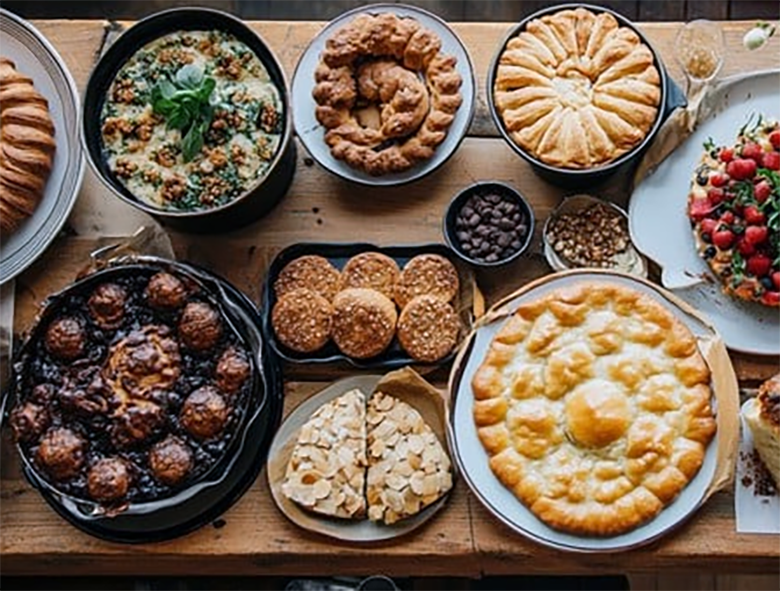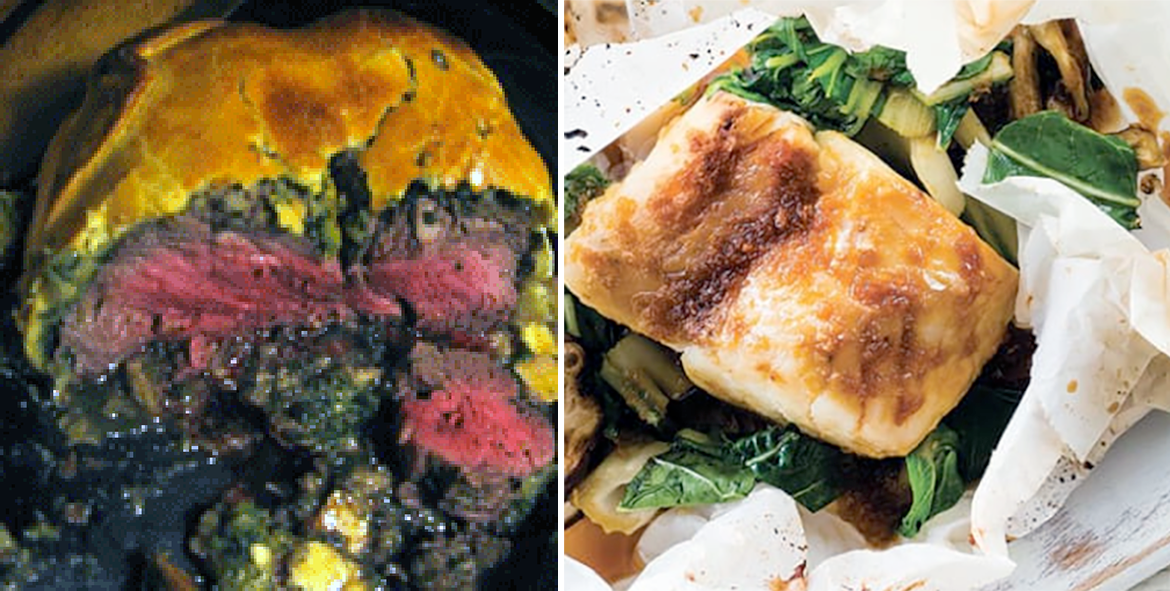FabulousFusionFood's Baking Recipes 21st Page
 A range of baked goods.
A range of baked goods.
Welcome to FabulousFusionFood's Baking Recipes Page — This is a continuation of an entire series of pages that will, I hope, allow my visitors to better navigate this site. As well as displaying recipes by name, country and region of origin I am now planning a whole series of pages where recipes can be located by meal type and main ingredient. This page gives a listing of all the baking recipes added to this site. Baking is defined as a technique for the prolonged cooking of food using dry heat by the action of conduction. Baking is normally done in an oven, but goods may also be baked in hot ashes or on hot stones. Baking differs from Roasting Recipes in that a lower temperature is typically used and the items are cooked for a longer period of time. Baking is a much older process than most people think and foods were probably originally baked in embers or with hot stones (which is how bread may have started). Only later did specialist ovens develop. Though most baked goods tend to be bread or cake-based some other dishes such as pasta dishes and vegetable dishes may also be baked. Stews are often also technically baked in an oven, but are not classed as 'baked goods' in that they are more liquid than solid at the end of the cooking process.
Baking is a method of preparing food that uses dry heat, typically in an oven, but can also be done in hot ashes, or on hot stones. The most common baked item is bread, but many other types of foods can be baked. Heat is gradually transferred "from the surface of cakes, biscuits and cookies, and pieces of bread to their centre, typically conducted at elevated temperatures surpassing 150°C. Dry heat cooking imparts a distinctive richness to foods through the processes of caramelization and surface browning. As heat travels through, it transforms batters and doughs into baked goods and more with a firm dry crust and a softer centre. Baking can be combined with grilling to produce a hybrid barbecue variant by using both methods simultaneously, or one after the other. Baking is related to barbecuing because the concept of the masonry oven is similar to that of a smoke pit.
In addition to bread, baking is used to prepare cakes, pastries, pies, tarts, quiches, biscuits and cookies, scones, crackers, pretzels, and more. These popular items are known collectively as 'baked goods', and are often sold at a bakery, which is a store that carries only baked goods, or at markets, grocery stores, farmers markets or through other venues.
 Beef en croûte (left) and fish en papillote (right).
Beef en croûte (left) and fish en papillote (right).
The alphabetical list of all the baking recipes on this site follows, (limited to 100 recipes per page). There are 2282 recipes in total:
Page 21 of 23
| Tafell Fricyll a Cheirch (Apricot and Oat Slice) Origin: Welsh | Tarten Gwreiddlysiau wedi’i Charameleiddio (Caramelised Root Vegetable Tart) Origin: Welsh | Teisen Gaws Pice ar y Maen Pob (Baked Welshcake Cheesecake) Origin: Welsh |
| Taffi Triog (Welsh Treacle Toffee) Origin: Welsh | Tarten Llus (Bilberry Tart) Origin: Welsh | Teisen Geni (Huish Cake) Origin: Welsh |
| Taita (Eritrean Flatbread) Origin: Eritrea | Tarten Oen a Bricyll gyda Crwst Persli (Lamb and Apricot Pie with Parsley Crust) Origin: Welsh | Teisen Hufen (Cream Pie) Origin: Welsh (Patagonia) |
| Tajine el Bey (Spinach and Rocotta Tagine) Origin: Algeria | Tarten Planc Rhiwbob (Rhubarb Bakestone Pie) Origin: Welsh | Teisen Lap Margarîn (Margarine 'Teisen Lap') Origin: Welsh |
| Tamal de Olla Origin: Panama | Tarten Rhiwbob a Mafon (Rhubarb and Raspberry Tart) Origin: Welsh | Teisen Lap: Ail Ffordd (Teisen Lap: Method 2) Origin: Welsh |
| Tandoori Monkfish Origin: Britain | Tarten Sawrus Eog (Savoury Salmon Tart) Origin: Welsh | Teisen Lap: Ffordd Gyntaf (Teisen Lap: Method 1) Origin: Welsh |
| Tantallon Cakes Origin: Scotland | Tarten Sibolau a Bacwn (Welsh Chipple and Bacon Pie) Origin: Welsh | Teisen Lard Ffermdy (Farmhouse Lardy Cake) Origin: Welsh |
| Tapioca Flour Bread Origin: Britain | Tarten Sibolau a Bacwn (Shepherd’s Pie with Cheese-crusted Leek Topping) Origin: Welsh | Teisen Llaeth Enwyn (Buttermilk Cake) Origin: Welsh |
| Tart au Citron (French Lemon Tart) Origin: France | Tarten Sipsi (Gypsy Tart) Origin: Welsh | Teisen Llaeth Enwyn (Soda Cake) Origin: Welsh |
| Tart au Citron Vert avec Sauce Cassis (Lime Tart with Cassis Sauce) Origin: France | Tarten Triog (Treacle Tart) Origin: Welsh | Teisen Môn (Anglesey Cake) Origin: Welsh |
| Tart de Bry (Pounded Cheese Tart) Origin: England | Tarten y Gororau (Welsh Borders Pudding) Origin: Welsh | Teisen Mêl a Sinsir (Honey and Ginger Cake) Origin: Welsh |
| Tart de ffruyte (A Fruit Pie) Origin: England | Tartes de Chare (Pies of Baked Meat) Origin: England | Teisen Nadolig Wen (White Christmas Cake) Origin: Welsh |
| Tart in Ymbre Day (Amber Day Tart) Origin: England | Tartes of Flesh (Meat Pie) Origin: England | Teisen Nionod (Welsh Onion Cake) Origin: Welsh |
| Tart Pastry Origin: Britain | Tartlettes/Tartletes (Tartlets) Origin: England | Teisen Nionod â Chig Oen (Welsh Onion Cake with Lamb) Origin: Welsh |
| Tarta de ricota clásica (Classic Ricotta Pie) Origin: Argentina | Tartys Choklet (Chocolate Tarts) Origin: England | Teisen Reis (Boiled Rice Cake) Origin: Welsh |
| Tarte a L'oingon (Onion Tart) Origin: Haiti | Tatws Popty (Potatoes in the Oven) Origin: Welsh | Teisen Sbeis Eirin a Chnau (Spiced Plum and Nut Cake) Origin: Welsh (Patagonia) |
| Tarte à la mangue 1 (Mango Tart with Mango Custard Filling) Origin: Saint Barthelemy | Tatws Popty Eidion (Beef and Potatoes in the Oven) Origin: Welsh | Teisen Simnel (Simnel Cake) Origin: Welsh |
| Tarte à la mangue 2 (Mango Tart with Pastry Cream and Mango Custard Filling) Origin: Saint Barthelemy | Tatws Popty Porc (Pork and Potatoes in the Oven) Origin: Welsh | Teisen y Cynhaeaf (Harvest Cake) Origin: Welsh |
| Tarte à la mangue 3 (Mango Tart with Pastry Cream and Fresh Mango Slices) Origin: Saint Barthelemy | Tavë Kosi (Baked Lamb and Yoghurt) Origin: Albania | Teisennau 'Berffro ('Berffro Cakes) Origin: Welsh |
| Tarte au fromage blanc (White Cheeseeake) Origin: France | Tea Scones Origin: Scotland | Teisennau Aberffraw (Aberffraw Biscuits) Origin: Welsh |
| Tarte au Sucre (Sugar Pie) Origin: Canada | Teisen Borc (Welsh Pork Cake) Origin: Welsh | Teisennau Bach Mel (Honey Tarts) Origin: Welsh |
| Tarte aux oignons de Roscoff (Roscoff onion tart) Origin: France | Teisen Cariad (Welsh Love Cake) Origin: Welsh | Teisennau Ffair Llangadog (Llangadog Fair Cakes) Origin: Welsh |
| Tarte aux Pommes Bretonne (Breton Apple Pie) Origin: France | Teisen Ceulfwyd Bro Gŵyr (Gower Peninsula Dowset) Origin: Welsh | Teisennau Jam Spwng (Welsh Cheese Cakes) Origin: Welsh |
| Tarte noix de Coco (Coconut Tart) Origin: Saint-Martin | Teisen Cnau a Ffrwythau (Fruit and Nut Cake) Origin: Welsh | Teisennau Mêl (Welsh Honey Cakes) Origin: Welsh |
| Tarten Afal (Welsh Apple Tart) Origin: Welsh | Teisen Datws Pob (Baked Potato Cake) Origin: Welsh | Teisennu Briwsionu Cyffug Mêl Penfro (Pembrokeshire honey fudge crumblies) Origin: Welsh |
| Tarten Afal a Chaws (Apple and Cheese Tart) Origin: Welsh | Teisen Ddu (Black Cake) Origin: Welsh | Tempting Trifle Cheesecake Origin: Britain |
| Tarten Bricyll a Mafon (Apricot and Raspberry Tart) Origin: Welsh | Teisen Ddu Nadolig (Black Christmas Cake) Origin: Welsh | Terrine de saumoun aux Quatre algues (Terrine of Salmon with Quatre Algues) Origin: France |
| Tarten Bwmpen (Marrow Pie) Origin: Welsh | Teisen De (Tea-time Cake) Origin: Welsh | Terrine Verte (Wild Greens Terrine) Origin: Switzerland |
| Tarten Caws a Chennin (Cheese and Leek Tart) Origin: Welsh | Teisen Dorth Margam (Margam Loaf Cake) Origin: Welsh | Tesen Aval (Cornish Apple Cake) Origin: England |
| Tarten Ceirios (Cherry Tart) Origin: Welsh | Teisen Dros Nos (Overnight Cake) Origin: Welsh | Teviotdale Pie Origin: Scotland |
| Tarten Cig Moch â Thatws (Bacon and Potato Pie) Origin: Welsh | Teisen Fêl (Honey Cake) Origin: Welsh | Thai Hake Bites Origin: South Africa |
| Tarten Eidion Tun (Corned Beef Pie) Origin: Welsh | Teisen Fferm (Farmhouse Cake) Origin: Welsh | The Perfect Pastry Origin: Britain |
| Tarten Eirin (Plum Tart) Origin: Welsh | Teisen Frau Gellyg Ffres a Mascarpone (Fresh Pear and Mascarpone Shortcake) Origin: Welsh | |
| Tarten Eirin Mair (Gooseberry Tart) Origin: Welsh | Teisen Frau Noswaith Lawen (Merry Evening Shortbread) Origin: Welsh |
Page 21 of 23